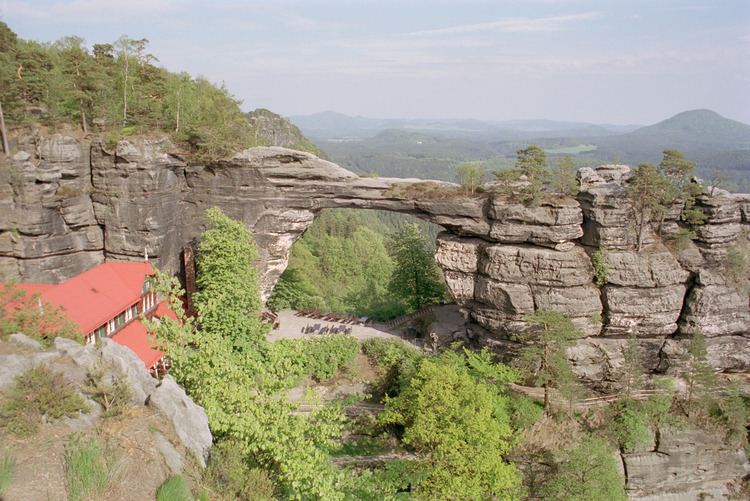Governing body Správa Ochrany Přírody Area 79 km² | Established 2000 Founded 1 January 2000 Phone +420 412 354 050 | |
 | ||
Similar Pravčická brána, Elbe Sandstone Mountains, Kamnitz Gorge, Bastei, Děčínský Sněžník Profiles | ||
Czech republic hiking in bohemian switzerland
Bohemian Switzerland (Czech: České Švýcarsko; German: Böhmische Schweiz), also known as Czech Switzerland, is a picturesque region in the north-western Czech Republic. It lies on the Czech side of the Elbe Sandstone Mountains north of Děčín on both sides of the Elbe River. It extends eastward into the Lusatian Mountains and westward into the Ore Mountains. Its highest elevation is the mountain Děčínský Sněžník at 726m above sea level. It has been a protected area (as ChKO Labske Piskovce) since 1972.
Contents
- Czech republic hiking in bohemian switzerland
- Travel to bohemian switzerland czech republic in 4k
- EtymologyEdit
- HistoryEdit
- National parkEdit
- SightsEdit
- References
The region along the right side of the Elbe became a national park on January 1, 2000, the České Švýcarsko National Park. The National Park is adjacent to the Saxon Switzerland National Park (Sächsische Schweiz) in Germany.
Travel to bohemian switzerland czech republic in 4k
EtymologyEdit
The concept of Bohemian Switzerland developed in the 18th century as an extension of the Saxon Switzerland, the part of the Elbe Sandstone Mountains in Germany. The name was inspired by the Swiss artists Adrian Zingg and Anton Graff, who were reminded of their homeland by the geography of northern Bohemia.
HistoryEdit
A large number of castles were built in the Bohemian Switzerland region in order to guard the trade routes. Several of these castles were also used as medieval robber baron hideouts. The region had been very sparsely populated since ancient times by a few Germanic, Slavic and Celtic tribes, but was finally colonised in the 12th century by German-speaking settlers. Until the end of the Second World War it was home to German Bohemians (later known as the Sudeten Germans). Since its German population was driven out after 1945, the area has been almost exclusively settled by Czechs.
The area first began to draw tourists in large numbers in the 19th century. Artistis of the Romantic era were inspired by the wild beauty of the rocks. For example, the artist, Ludwig Richter or the composer, Carl Maria von Weber, who set his famous opera Der Freischütz in the vicinity of Rathen.
National parkEdit
As early as 1972, the whole of Bohemian Switzerland was placed under protection. When, in 1990, the status of Saxon Switzerland was raised to that of a national park, efforts were stepped up to place the Bohemian part of the Elbe Sandstone Mountains under national park protection as well. A plan devised in 1991 envisaged that this would also include the Růžovský vrch (formerly Rosenberg). This plan was heavily resisted by various groups, such as the owners of hunting land and the forestry industry. A compromise proposal also fell on stony ground. In 1999 the Czech government decided to create the Bohemian Switzerland National Park (Národní park České Švýcarsko) to its originally envisaged extent. On 1 January 2000 the valuable forest and rock landscape, the gorges of the Kamnitz and the area around the Růžovský vrch were given national park status. The headquarters of the national park authority is located in Krásná Lípa (Schönlinde), and there are information offices in Hřensko (Herrnskretschen) and Jetřichovice (Dittersbach).
